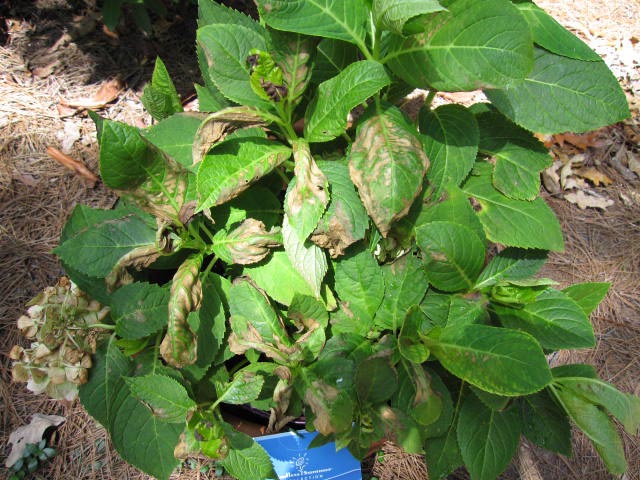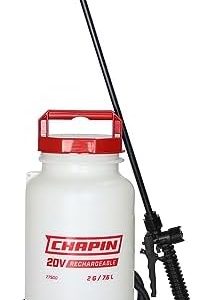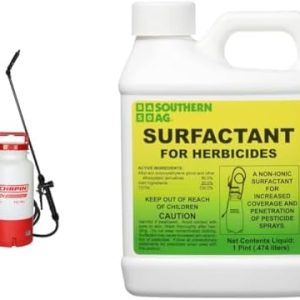Insecticide For Hydrangeas
Hydrangeas aren’t particularly enjoyed by pests and bugs, but occasionally there are a few pests that will cause trouble.

Sometimes, it’s the leaves of your hydrangeas that suffer the pest attack, other times, bugs will wreak havoc on blooms.
Knowing which pests or bugs take a liking to your hydrangeas and what you can do about them will help you prevent attacks or treat the ones that underway.
Below, I cover all the pests that may threaten your hydrangeas and offer solutions on how you can get rid of them quickly and efficiently.
Common Hydrangea Pests & Treatments
Pests, insects and bugs can set up shop on your hydrangeas causing all sorts of trouble. Here are the most common ones you should watch out for:
– Aphids
Aphids are small, green or black insects that feed on the sap of plants causing leaves to curl. To feed on the sap, these soft-bodied insects will usually attack new growths because they’re much easier to penetrate.
Ants on your hydrangeas can also indicate an underlying aphid problem because ants like to feed on the honeydew left behind by aphids.
If you don’t want to go down the route of insecticidal soaps and sprays, you can try addressing the issue by first spray hosing down the leaves with water.
If this doesn’t work, you’ll need to spray your hydrangeas with a broad range insecticidal soap or one that’s formulated to kill off aphids.
– Beetles
You’ll be quick to notice these bugs with shiny green and brown bodies munching on the petals or leaves of your hydrangeas.
Swarms of beetles can take down an entire plant in a matter of days, so if you notice them on your hydrangeas, it’s best that you take them down first.
The most straightforward way to deal with them is to remove them manually. Pesticides are another option.
– Slugs
Slugs are another pest that can start eating the leaves of your hydrangeas if decaying matter is not around for them to feed on instead.
Ragged leaf edges or holes in your hydrangea leaves signal a slug problem. Slugs are active at night and can be captured with slug traps.
You can also spray the plant with soapy water to deter them from the leaves.
– Spider Mites
Spider mites gather on the underside of leaves and spin protective silk webs. As insects that feed on the sap of plants, they puncture leaves.
The webs are one way to tell if you have a spider mite infestation; the other way is to look for yellow or off-white spots on the leaves.
Spider mites thrive in hot and dry conditions. To treat a spider mite infestation, you can use miticides, natural or not, such as neem oil and Pyrethrum.
Ladybugs are a natural predator of spider mites. You can introduce ladybugs to your garden, and they will help you keep spider mites at bay.
– Whiteflies
Another sap-feeding insect that can damage hydrangeas are whiteflies. These are small, 1/16 inch long, white-winged insects that live on leaves.
Symptoms of a whitefly infestation include yellowing of the leaves, accumulation of honeydew (and ants as a corollary). In advanced cases, stunted growth and dieback can also be observed.
As far as insecticides go, the insecticide imidacloprid is most efficient against whiteflies. However, it has a detrimental effect on pollinators and other beneficial insects, so you might want to use it as a last resort.
Natural alternatives include neem oil or you can use a homemade mixture of dish soap, water and rubbing alcohol.
Keeping Pests Away
There are a few ways you can reduce the occurrence of infestations and bug problems:
– Planting distance
Unless you’re planning a hydrangea hedge, don’t plant your hydrangeas too close to each other.
Depending on variety keep a 6-8 foot distance between hydrangea shrubs.
This will reduce the chances of pests and other diseases spreading from one shrub to the other.
– Watering
Water your hydrangeas at the base of the plant so that leaves don’t get wet.
This can cause fungal diseases. Water in the early morning so that leaves have enough time to dry should they get wet.
Because some insects thrive when the weather is dry and warm, hosing down the leaves of your hydrangeas can help.
But make sure the stream is not too strong as it can easily damage leaves.
– Pruning
Remove dead, diseased leaves and blooms, especially to increase aeration, which will reduce diseases, but it can also keep some pests away.
When pruning, make sure to disinfect blades between snips to avoid spreading diseases and eggs of pests to other parts of the same shrub or to other shrubs.
– Preventative spraying
Spraying with organic pesticides or insecticides like neem oil or other commercially available ready-to-use formulations can help prevent pest problems.
Spraying your hydrangeas from time to time will keep pests at bay and/or reduce their numbers.
– Visual inspection of leaves
Prevention starts with monitoring the state of your hydrangeas.
Visually inspect the leaves at every watering and take a peek at the underside of the leaves too, since many pests set up shop there.
When possible, remove pests manually (e.g., slugs, beetles). If there are heavily infested leaves or entire stems, you can remove them to prevent spreading.
Identifying the problem and applying the treatment on time will reduce the likelihood of serious damage and uncontrollable infestation.
– Natural predators
One of the easiest ways to deal with certain pest problems is to introduce beneficial bugs into your garden that will feed on these pests without damaging your plants. Ladybugs can remove a lot of pests including spider mites.
Wrap Up
While hydrangeas aren’t a particularly delectable treat to pests and insects, they do get infested occasionally.
Some of the pests will attack leaves, others will munch on bloom petals.
Prevention is the best strategy to deal with pesky pests, but don’t dismiss treatment options either when it comes to it.
Favor organic, natural pest repellents in your preventative care or treatment regimen and reach for the hard chemicals only as a last resort.
Insecticide For Hydrangeas
Hydrangeas are delicate, beautiful flowers that can be a beautiful addition to any garden. However, they’re also delicate and can be susceptible to pests. Luckily, there’s an insecticide for hydrangeas that will help keep your plants healthy!
This product works by penetrating into the insect’s body and making it unable to move or even survive. The active ingredient in
The best way to use this product is by spraying your plants once a week during the growing season (spring through fall).
List Of Insecticide For Hydrangeas
- INSECT KILLER: Kills 100+ insects including Aphids, Caterpillars, Whiteflies, Japanese Beetles, and more
- KILLS ON CONTACT: Kills listed insects on contact
- 14 DAY PROTECTION: Protects against listed insects for up to 14 days
- USE ON: Roses, flowers, plants, and even vegetable gardens
Additional Info :
| Color | White |
| Item Dimensions | |
| Height | 1 Inches |
| Width | 1 Inches |
| Length | 1 Inches |
| Release Date | 2021-11-11T00:00:01Z |
- READY TO USE – These convenient granules are ready for use and provide effective, long lasting insect control for up to 8 weeks in your flower beds, roses, and shrubs. Apply it every 8 weeks throughout the growing season for optimal protection.
- PEST CONTROL – Bonide Systemic Granules kill tough houseplant pests like fungus, gnats, mealybug, whitefly, termite, aphids, and more. Be considerate of animals and bugs like hummingbirds and bees that could be harmed from use of this product.
- NO SPRAYING – There is no mess associated with this pesticide because it is not a spray. The dry-application granules are easy to use, control, and apply without worrying about destroying clothing or other plants.
- FOR NON-EDIBLE PLANTS – This insect killer treatment is not meant for vegetable or fruit plants. This product is labeled for use on flower beds, roses, shrubs, and the like, but it is not labeled for use on any edibles.
- HOW IT WORKS – After incorporating the granules into the soil and watering them in, the pesticide is absorbed by the roots where it moves through the plants to assist in protection against the listed bugs.
Additional Info :
| Item Dimensions | |
| Height | 1 Inches |
| Width | 1 Inches |
| Length | 1 Inches |
| Weight | 1 Pounds |
- 3-IN-1 GARDEN SPRAY – Earth’s Ally 3-in-1 Plant Spray is an insecticide, miticide and fungicide. The formula effectively controls soft-bodied insects and common plant diseases with a synergistic blend of botanical oils.
- KILLS AND REPELS INSECTS – Kills common soft-bodied insects including spider mites, aphids, whiteflies, mealybugs, leaf rollers and scale.
- CONTROLS AND PREVENTS DISEASE – Controls common plant disease including powdery mildew, downy mildew, blight, canker, black spot and leaf spot.
- SAFE FOR PEOPLE, PETS & PLANET – Formulated with safe ingredients, the actives in Earth’s Ally 3-in-1 Plant Spray are thyme oil, rosemary oil, clove oil and peppermint oil. It is an OMRI Listed formula suitable for use in organic gardening.
- PROVEN BEE SAFE – Earth’s Ally is committed to protecting our pollinators. Every formula is independently tested and proven safe for the bee population.
Additional Info :
| Item Dimensions | |
| Weight | 1.5 Pounds |
- KILLS FAST: Kills mosquitoes, listed ant types, fleas and other listed insects
- QUICKFLIP HOSE-END SPRAYER: Hose-end-sprayer activates spray at the flip of a switch – just grip, flip and go
- LASTS ALL SUMMER: Controls up to 12 weeks against house crickets, carpenter ants, harvester ants, lady beetles and earwigs
- COVERAGE: Treats up to 5,000 square feet of lawn
- NO MIXING REQUIRED: Attach the sprayer to a garden hose to treat your lawn, landscape and outdoor surfaces where insects hide
Additional Info :
| Color | Silver Bottle |
| Item Dimensions | |
| Height | 11.5 Inches |
| Width | 2 Inches |
| Length | 5.25 Inches |
| Weight | 1.08 Pounds |
- INSECT KILLER: Kills Aphids, Caterpillars, Whiteflies, Japanese Beetles, and more on contact
- 30 DAY PROTECTION: Protects against listed insects for up to 30 days
- USE ON: Roses, flowers, plants, and even houseplants
- RAINPROOF PROTECTION: Rainproof within 1 hour of application
- COVERAGE AREA: Treats up to 34 plants
- RESTRICTIONS: Restricted in CT, MD, & VT. Not for sale, sale into, distribution, and or use in Nassau, Suffolk, Kings and Queens counties of NY
Additional Info :
| Color | Ready-to-Use |
| Item Dimensions | |
| Height | 11.25 Inches |
| Width | 2.19 Inches |
| Length | 5 Inches |
| Weight | 0.00024 Pounds |







